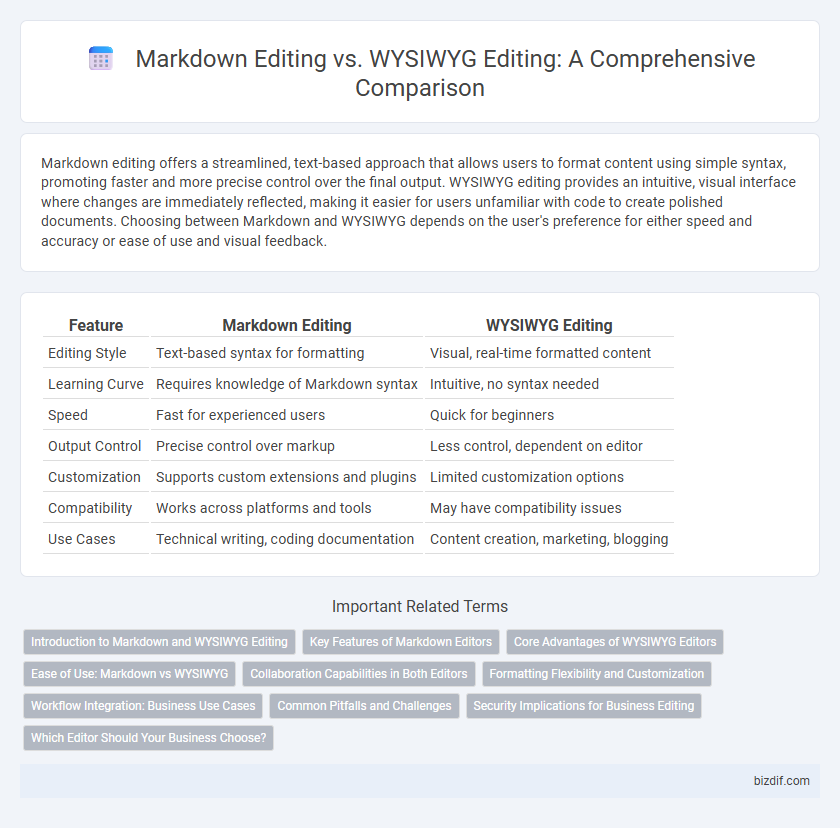Markdown editing offers a streamlined, text-based approach that allows users to format content using simple syntax, promoting faster and more precise control over the final output. WYSIWYG editing provides an intuitive, visual interface where changes are immediately reflected, making it easier for users unfamiliar with code to create polished documents. Choosing between Markdown and WYSIWYG depends on the user's preference for either speed and accuracy or ease of use and visual feedback.
Table of Comparison
| Feature | Markdown Editing | WYSIWYG Editing |
|---|---|---|
| Editing Style | Text-based syntax for formatting | Visual, real-time formatted content |
| Learning Curve | Requires knowledge of Markdown syntax | Intuitive, no syntax needed |
| Speed | Fast for experienced users | Quick for beginners |
| Output Control | Precise control over markup | Less control, dependent on editor |
| Customization | Supports custom extensions and plugins | Limited customization options |
| Compatibility | Works across platforms and tools | May have compatibility issues |
| Use Cases | Technical writing, coding documentation | Content creation, marketing, blogging |
Introduction to Markdown and WYSIWYG Editing
Markdown editing allows users to create formatted text using plain text syntax, making it easy to write and read without distracting formatting tools. WYSIWYG editing provides a visual interface where content appears as it will when published, enabling direct manipulation of text and multimedia elements. Both methods cater to different user preferences, with Markdown favoring efficiency and WYSIWYG emphasizing ease of use and immediate visual feedback.
Key Features of Markdown Editors
Markdown editors offer streamlined syntax for formatting text using plain text characters, enabling quick and efficient editing without complex menus. They support features like live preview, easy export to HTML or PDF, and compatibility with version control systems, making them ideal for developers and writers focused on clarity and portability. Unlike WYSIWYG editors, Markdown editors prioritize content structure and readability over immediate visual formatting.
Core Advantages of WYSIWYG Editors
WYSIWYG editors provide a core advantage by allowing users to see a real-time visual representation of the final document, eliminating the need for manual markup knowledge and reducing errors in formatting. These editors enhance productivity by offering intuitive drag-and-drop functionality, inline formatting tools, and immediate feedback on changes, which is especially beneficial for non-technical users. Compatibility with diverse content types, such as images, tables, and multimedia, further highlights WYSIWYG editors' strength in streamlining the editing process across various platforms.
Ease of Use: Markdown vs WYSIWYG
Markdown editing offers simplicity through plain text formatting, enabling quick, distraction-free content creation ideal for users comfortable with syntax. WYSIWYG editors provide a visual interface where users can format text and insert media without coding knowledge, enhancing accessibility for beginners. The choice depends on user preference for direct control versus intuitive, real-time visual feedback during editing.
Collaboration Capabilities in Both Editors
Markdown editing enhances collaboration by providing a clear and lightweight syntax that allows multiple users to easily track changes and merge content using version control systems like Git. WYSIWYG editors offer real-time collaborative features with simultaneous editing, commenting, and visual feedback, enabling non-technical users to participate seamlessly. Both approaches support team workflows, but Markdown excels in technical environments requiring precision, while WYSIWYG prioritizes accessibility and immediate visual context.
Formatting Flexibility and Customization
Markdown editing offers superior formatting flexibility by allowing users to apply precise syntax that supports a wide range of customization options, including custom CSS integration and advanced styling through inline HTML. WYSIWYG editors provide an intuitive, real-time visual interface but often limit the depth of customization by restricting access to underlying code and predefined formatting tools. Developers and content creators seeking granular control over document presentation typically favor Markdown for its adaptability and extensibility in formatting workflows.
Workflow Integration: Business Use Cases
Markdown editing enhances workflow integration by offering developers and content creators a lightweight, code-friendly format that easily integrates with version control systems like Git. WYSIWYG editing suits business use cases requiring non-technical users to produce polished content rapidly through intuitive interfaces, supporting real-time collaboration in platforms like Confluence and SharePoint. Organizations benefit from combining Markdown's precise syntax control for technical documentation with WYSIWYG's user-friendly approach for marketing and customer-facing content, optimizing productivity across diverse teams.
Common Pitfalls and Challenges
Markdown editing often poses challenges such as syntax errors and a steeper learning curve for beginners, making real-time formatting less intuitive compared to WYSIWYG editors. WYSIWYG editing can introduce issues like inconsistent HTML output, reduced control over markup, and difficulties in handling complex document structures. Both methods require balancing ease of use with precision, where Markdown excels in clean, semantic code while WYSIWYG prioritizes visual fidelity at the potential cost of code quality.
Security Implications for Business Editing
Markdown editing offers a lightweight, text-based format that limits exposure to embedded scripts, reducing potential security vulnerabilities compared to WYSIWYG editors. WYSIWYG editing can introduce risks through automatic HTML generation and embedded code execution, increasing the likelihood of cross-site scripting (XSS) attacks in business environments. Prioritizing Markdown editors enhances content integrity and minimizes security threats by restricting executable content and promoting safer editing workflows.
Which Editor Should Your Business Choose?
Markdown editing offers streamlined, code-based formatting preferred by developers and content creators who prioritize control and portability, while WYSIWYG editing provides intuitive, real-time visual adjustments suited for non-technical users seeking ease and immediate design feedback. Businesses should evaluate their team's technical proficiency, content complexity, and collaboration needs to select between markdown's flexibility or WYSIWYG's user-friendly interface. Choosing the right editor influences productivity, content consistency, and overall digital asset management efficiency.
Markdown Editing vs WYSIWYG Editing Infographic

 bizdif.com
bizdif.com